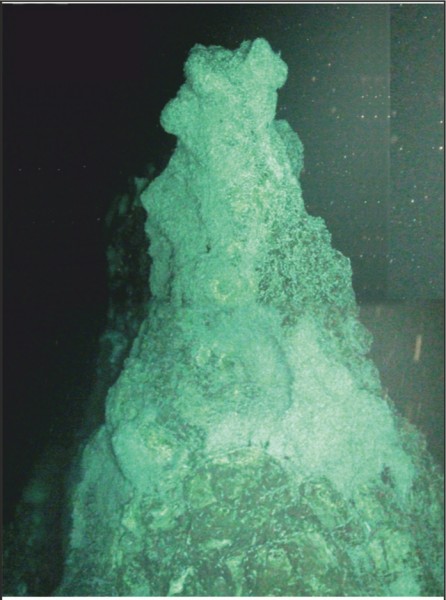New Kind of Hydrothermal Vent System Found in Caribbean

National Oceanography Centre, Southampton The main vent at the Von Damm vent field
Collaborating with colleagues at the National Oceanography Centre, the team has revealed active vents in the Von Damm Vent Field (VDVF) that are unusual in their structure, formed largely of talc, rather than the more usual sulphide minerals.
Lead researcher Matthew Hodgkinson and colleagues analysed samples from the VDVF – a vent field south of the Cayman Islands discovered by scientists and crew on board the RRS James Cook in 2010. Results of the analysis are now published in the journal Nature Communications.
Matthew comments: “This vent site is home to a community of fauna similar to those found at the Mid-Atlantic Ridge in the Atlantic Ocean, but the minerals and chemistry at the Von Damm site are very different to any other known vents.”
Hydrothermal vents form in areas where the Earth’s tectonic plates are spreading. At these sites, circulating seawater is heated by magma below the seafloor and becomes more acidic – leaching metals from the surrounding rocks and redepositing them as the hot water spews out of vents or ‘chimneys’ at the seabed and hits the cold seawater.
The scientists have also found the VDVF system has a very energetic heat flux (the amount of energy it emits into the surrounding ocean) of around 500 megawatts. This is much more than would be expected since the VDVF, on the slopes of an underwater mountain and away from a large magma supply, is on the edge of a spreading area and not in between two separating tectonic plates. The unusual positioning of this new vent field suggests that other similar ones elsewhere in the world may have been overlooked.
Matthew Hodgkinson adds: “If more of these unusual sites exist they could be important contributors in the exchange of chemicals and heat between the Earth’s interior and the oceans, and may be missing from current global assessments of hydrothermal impact on the oceans.”
Notes for editors:
1) For images from the Von Damm Vent Field and a copy of the paper Talc-dominated seafloor deposits reveal a new class of hydrothermal system
(Matthew R.S. Hodgkinson, Alexander P. Webber, Stephen Roberts,
Rachel A. Mills, Douglas P. Connelly & Bramley J. Murton, DOI: 10.1038/ncomms10150) please contact Peter Franklin, Media Relations, University of Southampton Tel 023 8059 5457 Email p.franklin@southampton.ac.uk
2) Through world-leading research and enterprise activities, the University of Southampton connects with businesses to create real-world solutions to global issues. Through its educational offering, it works with partners around the world to offer relevant, flexible education, which trains students for jobs not even thought of. This connectivity is what sets Southampton apart from the rest; we make connections and change the world.
www.southampton.ac.uk/weareconnected
#weareconnected
3) The National Oceanography Centre (NOC) is the UK’s leading institution for integrated coastal and deep ocean research. NOC undertakes and facilitates world-class agenda-setting scientific research to understand the global ocean by solving challenging multidisciplinary, large scale, long-term marine science problems to underpin international and UK public policy, business and wider society outcomes.
NOC operates the Royal Research Ships James Cook and Discovery and develops technology for coastal and deep ocean research. Working with its partners NOC provides long-term marine science capability including: sustained ocean observing, mapping and surveying; data management and scientific advice.
NOC operates at two sites, Southampton and Liverpool, with the headquarters based in Southampton.
Among the resources that NOC provides on behalf of the UK are the British Oceanographic Data Centre (BODC), the Marine Autonomous and Robotic Systems (MARS) facility, the National Tide and Sea Level Facility (NTSLF), the Permanent Service for Mean Sea Level (PSMSL) and British Ocean Sediment Core Research Facility (BOSCORF).
The National Oceanography Centre is wholly owned by the Natural Environment Research Council (NERC).
www.noc.ac.uk
For further information contact:
Peter Franklin, Media Relations, University of Southampton, Tel: 023 8059 5457, Email: p.franklin@southampton.ac.uk
Follow us on twitter: www.twitter.com/unisouthampton
Like us on Facebook: www.facebook.com/unisouthampton
Media Contact
All latest news from the category: Earth Sciences
Earth Sciences (also referred to as Geosciences), which deals with basic issues surrounding our planet, plays a vital role in the area of energy and raw materials supply.
Earth Sciences comprises subjects such as geology, geography, geological informatics, paleontology, mineralogy, petrography, crystallography, geophysics, geodesy, glaciology, cartography, photogrammetry, meteorology and seismology, early-warning systems, earthquake research and polar research.
Newest articles

First-of-its-kind study uses remote sensing to monitor plastic debris in rivers and lakes
Remote sensing creates a cost-effective solution to monitoring plastic pollution. A first-of-its-kind study from researchers at the University of Minnesota Twin Cities shows how remote sensing can help monitor and…

Laser-based artificial neuron mimics nerve cell functions at lightning speed
With a processing speed a billion times faster than nature, chip-based laser neuron could help advance AI tasks such as pattern recognition and sequence prediction. Researchers have developed a laser-based…

Optimising the processing of plastic waste
Just one look in the yellow bin reveals a colourful jumble of different types of plastic. However, the purer and more uniform plastic waste is, the easier it is to…



